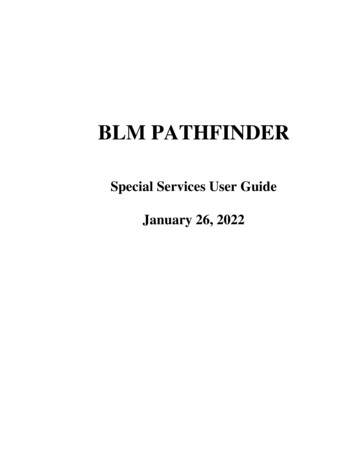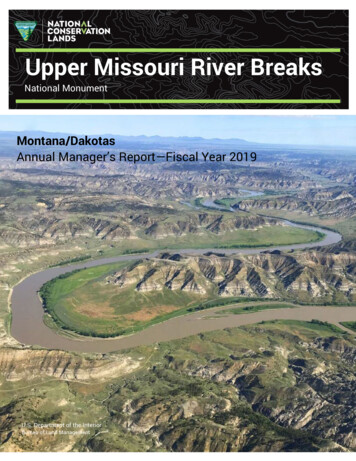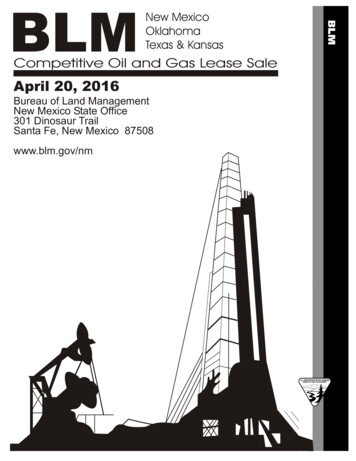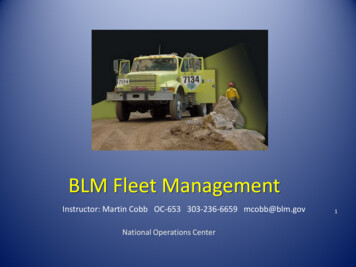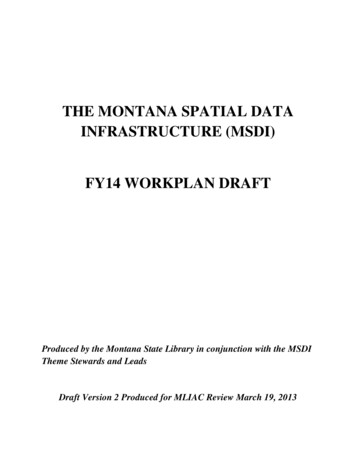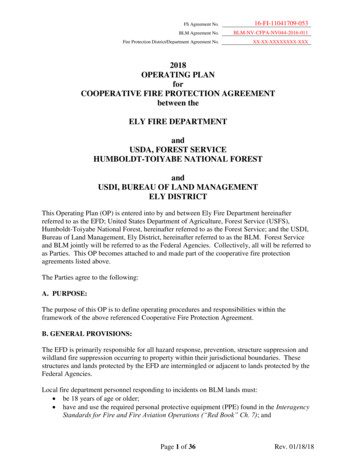
Transcription
A
Hi!Welcome to the Nevada Adventure Book where you can travel to six differentsites in Nevada. Each story is an adventure with an end of story activity.Take this book with you on your adventures to these places. The BLM’sJunior Explorer Program helps introduce young explorers like you to thelands and resources that the BLM manages. We hope to see you soon.Your friends at BLM NevadaPage 1 Note: All coordinates located in UTM Zone 11Let’s Stay TogetherGPS/UTM: 443755 E 4530882 NPage 6Imagine Life Along the TrailGPS/UTM: 590094 E 4512919 NPage 11A Day With Our PastGPS/UTM: 359750 E 4363452 NPage 16Scary Movie in Ghost TownGPS/UTM: 515188 E 4083536 NPage 21Welcome to My Home theWildernessGPS/UTM: 733333 E 4237132 NPage 26A Day with Nature at SloanCanyon National Conservation AreaGPS/UTM: 667043 E 3971229 NThis Book Belongs -----------Stories Developed by BLM Nevada Team and Writer Arthur DonaldsonEdited by BLM Nevada Team and Editor Nic WhitsonCover Design, Typesetting and Illustrations by Clarisa AdonisThe Key Publishing House Inc. GSA Contract Holder GS-02F-0149YA
It was a Saturday morning in mid-June. I jumped out of bed and ran downstairs. I found Dad andMom drinking their coffee, but Danny, my brother, was still asleep in his room so I went to wake him.“Danny wake up and get ready for our camping trip hurry wake up.” I whispered in his ear. “Hope,why so early?” asked Danny. “So you can get ready quickly and join us for breakfast.” I giggled.Everyone was excited about the camping trip. We loaded our camping stuff inside the car, andDad loaded our bikes carefully on the roof. “Now we are ready for the journey,” said Dad. Momcalled Grandma and told her where we were going so, in case of an emergency, Grandma knewwhere we are.“Where are we going, and how far is it?” I asked.“We’re going to Water Canyon. It’s a few miles east of here.” Dad replied. “We’re going mountainbiking on a three and half mile trail from Water Canyon to the Bloody Shins Trail System.”Mom added.“Why is it called Bloody Shins?” Danny asked.“When you ride your mountain bike on these single track trails there are places along the trailwhere the brush is thick and can scratch your shins.” Dad answered, smiling. “You two be carefulnot to scratch your shins too much while riding.”“What does Water Canyon look like, and who takes care of it?”I asked.A1
Mom replied, “Water Canyon rises about 2,000 feet above the town of Winnemucca. It is one ofthe great recreation areas in Northern Nevada. It is very natural, rocky, rough but very pretty aswell.” Then Dad added, “It is managed by the BLM-Winnemucca District Office.”“BLM? Who is BLM? Are we going to meet BLM?” Danny asked.“BLM is an abbreviation for the Bureau of Land Management. Every American, including Hopeand you, owns these lands and BLM is the government agency that’s responsible for taking careof our public lands for us.” Mom explained.“What’s in Water Canyon?” Danny asked. Before Dad could say anything, Mom replied, “Thereare facilities for overnight camping and picnicking plus there are trails for hiking, mountainbiking, horseback riding, and many other different activities.” Mom then reminded us there arelimited services there, we had to bring our own food and water with us, and we would have tomake sure to collect all our trash before we left the campsite.A2
We drove up Water Canyon Road and found our campsite. We got out and unloaded the tent, thecooler, and a soccer ball. Our food was still in the shopping bags - bread, carrots, peanut butter,fruits, juices, water, and a variety of other food and trail mix.Mom and Dad started to organize our stuff, but Danny and I were too excited to help, so we leftthem and ran all around the campsite. It was so beautiful!“This campsite is awesome,” I said to Danny. “Look at the other campers unpacking like us. Overthere is one of those really big cars, I think they are called recreational vehicles (RVs).”After setting up our campsite, Dad got all our mountain bikes and equipment ready. We all put onour sneakers, helmets and sunglasses and we were ready to go. Dad put on his backpack, whichwas filled with water, trail mix, a map, a GPS navigation device, sunscreen, a flashlight, a first aidkit, matches, and a knife, and we started our ride.We rode along the rough and dirty trail. I was afraid I would slip and fall as Mom, Dad andDanny rode very fast, and went ahead of me. I didn’t mind riding slowly because I was enjoyingthe natural surroundings, smelling the plants and brush, and seeing new things. But, I fell behindeveryone and soon felt like I was lost. I was panicking a bit, but suddenly I remembered myMom’s advice, “If anyone gets lost, just stay where you are and don’t move anywhere.” I stoppedriding and stood calmly next to my bike.After a couple of minutes, I heard the voices of my Mom, Dad and Danny shouting loudly,“Hope Hope Hope, where are you?” I shouted back, “I’m over here.” They came back andlooked so relieved to see me. We hugged and got back on our mountain bikes.A3
We reached the top of a big hill. From there we saw gorgeous scenery all around us. We spentplenty of time riding and enjoying the natural beauty of the area.Soon it was evening, and it was beginning to get dark, so Dad and Mom decided we should returnto our camp. I was a bit tired, but I was so happy and I smiled all the way back. Mom and Dadprepared dinner while Danny and I walked around and met the other kids who were campingthere too.“Kids, dinner’s ready!” Mom shouted. We ran back to our camp and ate dinner then had s’moresby the fire. After the sky turned dark, we were able to see the stars. They were twinkling all overthe sky and sparkled like Mom’s diamond ring. Oh, what a joy to sleep in our tent under the starsamong the peace and quiet of nature.In the morning, we ate breakfast and sat by the creek. Then we cleaned up our area, and packedall our stuff, including our garbage, in the car to return home.When we got home, I sat on my bed and thought about Water Canyon. What a beautiful place!It was my first time camping, and I have to say that I was happy. Earlier, I asked Dad when wewould go back and he promised me, we would go camping again before the end of the summer.Mom came to tuck me in. She kissed me good night, hugged me tight, and said, “I am so proud ofyou, Hope. Your first camping trip and you were so brave and helped me with everything.”“Thanks.” I laughed and said, “Can we move to Water Canyon? It’s so much fun, when I growup I want to be a park ranger.” Mom smiled and said “Maybe.” Then I dozed off and starteddreaming about the mountains, the stars, and the s’mores yummy.4A
G.O.R.P.“G.O.R.P.” stands for “Good Old Raisins and Peanuts.” To make this yummy camp snack atcamp or at home, mix the following ingredients together. It’s easy! 1 cup of Granola 1 cup of chocolate chips 1 cup of raisins 1 cup of peanuts other dried fruits (optional) other dried nuts (optional)S’moresGet an adult to help you with this one. Usually S’mores require a campfire to roast the marshmallow and melt the chocolate a bit, but at home you can assemble the S’mores, place them ona plate and very briefly microwave them.Here’s what you’ll need. 2 graham crackers 1 large marshmallow a few chocolate chips or half of a Hershey bar a microwave oven safe platePlace the marshmallow and chocolate inside the two graham crackers (like a sandwich) andplace it on the plate. Microwave for only a few seconds at a time– perhaps 20 or so. Be careful!It’ll be hot, but you’ll have a melted gooey treat!!!Always tell someone where you are going, like yourGrandma or neighbor. To avoid being left behind like Idid or even getting lost, stay with your group and stayon the trail. Once you realize you are behind or loststay in one place until your group finds you.A5
I heard Grace wake up earlier than usual. She’s ten years old and an expert with her wheelchair.She was adopted from China and her Chinese name is Eun which means Grace. She heard herMom and Dad laughing in the kitchen, talking about the day trip to the California National HistoricTrail Interpretive Center just outside of Elko in northeastern Nevada.Excitedly, Grace sat in her bed for a while thinking about the trip ahead. She turned on thelight, picked me up from under the covers and said, “Good morning Oxy! You know you are myfavorite toy in the whole wide world.” She hugged me and added, “Today we are going to havefun on the California Trail.”After brushing her teeth and washing her face, Grace made her bed, put me on her lap and rolledto the kitchen to eat breakfast. “Grace, are you going to take your toy ox, Oxy, with you on thetrail?” Mom asked us. I was very frightened of being left out, but happily for me, Grace said, “YesMommy, Oxy is coming with us.”As we approached the Center, we sawpeople walking on the plaza readingthe interpretive signs and looking atthe statue of the Shoshone womanrepresenting the first people theemigrants saw along the trail. AfterDad parked the car, Mom helpedGrace and me into the wheelchair andwe entered the main building. Dadwas pushing Grace’s wheelchair andstopped in front of a giant elephantstatue.“What is the story behind thisgigantic elephant?” asked Grace. Aninterpreter at the Center explained,“Back in the day, when people asked:‘Did you see the Elephant?’ It meantexperiencing an event that was largerthan life that was too hard to describe.Something that one had to experiencefor yourself.” Dad carried on theA6
conversation, “Remember, this was a very hardtrip for the emigrants. They encountered difficultchallenges along the trail. They had to experience forthemselves the hard times before they could say, ‘Yeswe saw the elephant.’” Mom added, “You can applythis to today’s trail journey so saddle up (meaning‘let’s go’, as they used to say during pioneer times).”Grace turned me to face her and said, “You knowOxy, today we’ve got a lot to learn about this trail.Keep your ears open and listen carefully.” Momlaughed and added, “This is an exceptional placeto appreciate how people lived, and how lucky weare today. Back in the time of emigrant travel, wewould’ve been called Greenhorns, which means‘inexperienced persons’.”I kept my ears open like Grace said and learned the California Trail is the name for the route thatwent from western Missouri across the Great Plains, Rocky Mountains, and Great Basin to thegold fields of northern California. It was most used in the 1840s, 1850s, and 1860s. The lengthof the wagon trail from the Missouri River to Sacramento, California was about 1,950 miles. Itnormally took four to six months to travel the California Trail with covered wagons pulled bystrong oxen like me. About 250,000 pioneers used this route.During our visit to the California Trail InterpretiveCenter we experienced multimedia exhibits, life-sizedioramas, original art, and videos. The Trail Center isan example of living history and a wonderful place tolearn what traveling on the California Trail was like.Volunteers at the center taught Grace how to playsome old-fashioned pioneer games. There was adress up area where visitors could try on pioneerclothes. Grace put on a few things but she couldn’tfind anything to fit me. There were several wagonsthat displayed methods of food preparation such asDutch oven cooking.A7
Grace and I learned what was involved ingetting across the country before railroads,highways, or airplanes. We heard the groanof their wagons as they tipped and swayedcrossing the hostile environment. We smelledthe wood smoke of their fires, felt their grimeand sweat, and learned to yoke oxen and loadwagons with them. We also saw the homes thatNative Americans from the Shoshone tribe usedto build in the Shoshone summer camp outsidethe Trail Center. The houses were called BohoGahnee in the Shoshone language and werebuilt from the sagebrush plant.We were lucky to be visiting during the TrailDays celebration. This takes place every springand allows visitors to experience the lives ofemigrants during the trail period. One of theexhibitors showed us how to pan for gold.A woman and her daughter fiddled tunes toshow us the entertainment that was availablealong the Trail. A magician pulled a coin fromthe ear of a young boy. Finally, there was a manand his two sons riding their oxen-poweredwagon around and they showed us a first-handaccount of travel accommodations along theTrail. “Oh poor oxen, what a tough life.” Ithought. “It seems people and animals weretougher in those days,” said Dad.Grace said, “This must have been an extremelydifficult life for both humans and animals.Now I can imagine how much they struggledto survive the Trail journey in such harshconditions.”A8
At a reflective moment, Dad inspired us by saying: “Itis fascinating how the Bureau of Land Management(BLM) protects our public land and keeps this wholetrail alive for us to visit and learn. The Trail journeyis an important part of our American history. We’reprivileged to be able to experience it as if we weretraveling with the emigrants. That is why it is importantfor visitors to respect and help care for our public lands.”We also learned that Native Americans had been livingin the Humboldt Valley for 10,000-12,000 years. Whenthe pioneers traveling in their wagons arrived in theHumboldt Valley, native ways were changed forever.The Newe (meaning people in the Shoshone language)helped the emigrants in many ways. Most NativeAmericans were tolerant of the pioneer wagon trainsthat drove through their lands. Some traded food andmoccasins (Native American footwear) for knives, clothes,food and other items.It is very humbling to see our history and what the earlyemigrants did to pave the way for today. The only troublewas that we didn’t have enough time to explore the entiretrail. Briefly, we were able to explore the accessible hikingtrails adjacent to the Trail Center, which offer spectacularviews of the Ruby Mountains, the historic South ForkCanyon and the Humboldt River. I wish we’d had moretime. We’ll have to come back again!As we went back to the car, Grace proudly pulled hershoulders straight, thought about “seeing the elephant”and said, “Yes, I saw the elephant.” We laughed, and gotinto our car.A9
From the story, match up what you learned of what the pioneers would saycompared to how Grace and Oxy would say it today.A solution to the match up is provided at the back of the Book on page 33.The California Trail journey is an important part of ourAmerican history. Much of the Trail is on public landsand belongs to all Americans.That means everyone should help care for themto preserve our history for others to enjoy.10A
“Hurry Mom!” I said while looking out the window. “We’re going to be late!”“Tom,” Dad said as he turned, “Please be patient. Your Mom isn’t going to speed up.”A few minutes later my younger brother Harry shouted. “Look Tom! We’re here.” He pointed to asmall crowd in the Hidden Cave parking lot. “I can see the tour guide.” The guide was talking tothe tourists about the history of the area, as well as the plants and animals that can be seen alongthe trail.“He’s walking ahead!” I exclaimed. “We need to hurry or we’ll miss it.”After we left the car, I raced Harry along the three-quarter mile interpretive trail past the othervisitors to the tour guide. We eventually arrived at the top of the hill huffing and puffing in timeto watch the guide unlock the door that protects Hidden Cave from vandalism.I was excited to enter, especially after our earlier visit to the Churchill County Museum in Fallon,where we watched a short video about the history of the cave and looked at interesting artifacts ondisplay. We all learned the cave was originally formed by ancient Lake Lahontan around 21,000years ago and its continued evolution had been influenced by volcanic eruptions, the lake dryingup, and humans dating all the way back to 12,000 years ago.11A
“Do you know why it’s called the Hidden Cave?” the guide asked us as he unlocked the door.“Of course,” I replied. “It’s because Mr. Mark Harrington, who first excavated the cave, and hada hard time finding the entrance said at the time, This is certainly one very hidden cave!” ThenI continued, “The cave has since been excavated three times: once in 1940, again in 1951, andfinally in 1979-1980.”Once inside the cave, we learned how the excavations were carried out and followed the woodenwalkways down to see tools and seed caches. Dad reminded us how many of the artifacts werefound unbroken and arranged in concentrations, which suggested the cave was used a lot byNative peoples for storage 2,000 to 4,000 years ago, like how we use our attics to store stuff today.After leaving the cave, instead of driving, we decided to hike over to the picnic sites at GrimesPoint Rest Area for lunch. It was good Mom had made Dad, Harry and I wear our hiking shoes,because it was a mile and a half from the cave. This Saturday was turning out to be awesome!After lunch, we signed the visitor log at the trailhead and headed up the Grimes Point PetroglyphTrail where we learned from the interpretive panels that the trail was constructed by the YouthConservation Corps for the enjoyment of visitors and the protection of cultural resources in 1976,and was designated as Nevada’s very first National Recreation Trail.“A petroglyph is the name of prehistoric art etched into arock,” Dad explained as we walked on the easy, three-quartermile trail. “There are hundreds of boulders in Grimes Pointdecorated with circles, wavy lines, human figures, snakes andanimal figures.”A12
“Grimes Point was first visited by our Native American ancestors 8,000 or more years ago,” Momadded. “The rock art here is believed to be about 6,000 years old.”It was fascinating to see all of the inscribed rocks and how well preserved they are. As we finishedour tour, Mom continued her history lesson for us, “The area back then looked very different fromthe way it appears now. Up until the end of the Ice Age 10,000 to12,000 years ago, a vast networkof lakes covered much of Nevada and western Utah. As the ancient Lake Lahontan was dryingup, its marshy remnants were home to a wide variety of plants and animals which were used byprehistoric people.” Harry and I imagined the past landscape and ancient animals as we looked atthe petroglyphs and swapped ideas on what they might mean.Our final stop of the day was the Sand Springs Pony Express Station, about 16 miles east ofGrimes Point on US Highway 50 near Sand Mountain. The station was covered by sand foralmost one hundred years and lay undisturbed until 1976 when it was rediscovered by a teamof archaeologists. We walked around reading the interpretive signs in front of the remainingbuildings explaining the function of each room. We looked through each room carefully, beingsure not to disturb or climb on the rock walls, trying to recapture the past, and imagine how it wasto live then.“Some of the Pony Express riders weren’t much older than us!” I told Harry. “Imagine, way backin history at a time before there were airplanes, telephones, railroads or even a telegraph, the PonyExpress carried the mail 2,000 miles in just 12 days in the summer and 14 days in the winter.”A13
“The ponies and riders were special to be able to cover these distances,” said Dad. “As the CivilWar loomed, it provided the Union with a vital link to its far-flung Western territories, includingthe important silver mines of the Comstock and the gold fields of California. The Pony Expresslasted only 19 months, from April 1860 to November 1861, but it quickly became a legend.Racing against time, the Pony Express riders had to overcome vast distances and a harsh climate.”After we finished looking through the rooms of the station, we hiked the three-quarter mileinterpretive trail that starts and ends near the station. We learned interesting facts about the plantsand animals that survive in the sand dunes and saw the yucky old water holes that were used towater the ponies.“Boys,” said Dad, “The Pony Express was a job for brave boys and men who didn’t mindtremendous pressure, and enormous hardships.” “Some of them, like 14-year-old Billy Tate,died trying to maintain the communications link,” Mom added. “You should carefully considerwhether you really want to have had this hazardous job.”Harry and I both looked at each other and felt that we might have been Pony Express riders if wehad lived then and been old enough.As we approached the car discussing the most interesting things we had seen, Harry begged Momto show us how we could make our own petroglyph. Mom promised, and on the way back westopped for supplies.A14
The Native Americans carved petroglyph pictures into rock, but like Tom and Harry, you toocan easily make petroglyph art with crayons and markers First, here are some petroglyphdrawings to give you some ideas for you to draw on the rock below.Leave artifacts alone so other visitors can also enjoy them. Stay onthe trail. Straying off it destroys vegetation and may disturb a restingscorpion or snake. When exploring the remains of the Sand SpringsPony Express Station, please stay off the walls!A15
It was a nice evening and my family was eating dinner at the kitchen table. I’m the family dog,Flash, so I was eating my dinner from a bowl on the floor. Everyone was talking passionatelyabout different subjects, when Adam interrupted and asked, “Dad, you know I have to make ascary movie for Halloween, and you said you knew just the right place for that. When are wegoing?”“Let’s go this Saturday,” Dad said. “The place is a ghost town called Rhyolite, a historic townsitemanaged by the Bureau of Land Management (BLM).”“Where is this ghost town?” Adam asked. Before Dad answered, Adelina curiously added, “Whyis it called a ghost town?” I stood up, barked, wagged my tail, and everyone shouted, “Flash,quiet.” So I went back to my dinner. I had a feeling we were going on a trip. “It is called ghosttown because no one lives there anymore.” Mom answered.“The ghost town of Rhyolite is located northwest of Las Vegas, about four miles west of Beatty,Nevada. It’s about two and a half hours drive from Las Vegas,” Dad said. Mom added, “Accordingto records, in the early 1900s, people discovered gold and other minerals nearby in an area calledBullfrog Mountain. As a result, thousands of people moved and settled in the area.”A16
“Rhyolite grew fast and had everything a town needed,” Dad continued. “It had a school, a firedepartment, nice houses and streets, large stores, newspapers, phones, three railroads with tworailroad stations, banks, a doctor’s office and many other businesses. People had active sociallives including sports games, the symphony and going to the opera house.”Adam seemed puzzled and asked, “Then what happened to Rhyolite? Why did it become a ghosttown?”“Gold was discovered in the Bullfrog Hills in 1904 and within two years Rhyolite grew to 6,0007,000 people.” Dad explained. “Believe it or not, the San Francisco earthquake and fire of 1906affected many banks which financed the mines. A number of mines in Rhyolite closed in 1907 andpeople left town. By 1910 there were only approximately 700 people left in Rhyolite.”Adelina said, “This story is interesting, and will be perfect for our scary movie project. What doyou think, Flash? Do you want to come with us to the ghost town and star in the movie?”When I heard my name, I got excited and started chasing my tail in circles. Then I went closerto Adelina, and licked her leg happily. While Mom and Dad were cleaning up the dinner table,Adam sent text messages to his friends, Jimmy and Lucas, inviting them to come along. “Comeon Flash,” Adam called, “We have to decide on costumes to wear.”A17
We all raced upstairs to his room. The kidswere laughing and they started throwing oldercostumes at me and trying on different outfits. Bybedtime, we were all exhausted and had preparedeverything for our trip. I love going on trips withmy family.On Saturday, our friends Lucas and Jimmy cameover early and got dressed up in the costumeswe chose. I refused to wear anything so Adamput his orange hat on me which looked verydashing. We left home and started our day trip tothe ghost town of Rhyolite. Dad was driving andMom was sitting in the other front seat. Adam,Adelina, Lucas, Jimmy and I took the back seatsof the SUV. Everyone was so excited! They weresinging all the way and I barked along with them.After few hours driving, we finally arrived. Therewere a few cars in the parking area and peoplewalking around taking pictures. Dad parked andwe went to the host to learn about the town.Now it was time to film and I was pretty excitedabout being a movie star. Our movie director,Adam, gave us poses and told us to make scaryfaces. Dad was the camera man. He checkedeach building carefully before allowing us to gonear. We spent considerable time walking onthe roads in front of the buildings, shootingscenes for our scary movie and takingpictures. Adelina and Adam wanted to haveenough pictures so when they got back, theycould post them on social media sites to sharewith their friends. I was always on a leashsince there are many hazards in Rhyolitesuch as old privy holes and cesspools.It was a remarkable environment with differentkinds of buildings. I had never seen anythinglike it before. We shot scenes at the Tom KellyBottle House, the house made of empty beer18A
and liquor bottles laid on their sides and embedded in adobe mud mortar. Then we walked to theJohn S. Cook Bank Building. The bank is the tallest building in Rhyolite, and one of the mostphotographed buildings in town. It was a magnificent building and it’s a shame that it has falleninto ruins. After that we went to the Gorrill Building, the Rhyolite Jail House, the OverburyBuilding, and the HD & LD Porter Store. Dad said: “This Porter Store used to carry anything aperson needed.” We shot two scenes and took pictures then moved to the Las Vegas and TonopahRailroad Depot and Rhyolite School House for the final shots. After Adam and Lucas took thecamera from Dad and checked that they had enough footage to put together for the movie weheaded back to the car.It was a wonderful day and everyone was so happy. On the way back the kids were busy discussinghow they would organize the scenes to make the movie. The kids sent text messages to theirfriends about their new experiences at Rhyolite. Jimmy posted his adventures on his school’ssocial media site, “We had an awesome experience in a ghost town over a hundred years old. Staytuned for our upcoming movie on Halloween.”We made it home safe and sound. Mom gave everyone snacks and juice, and gave me dog treats too.She reminded Jimmy and Lucas to take brochures home so their families can also visit Rhyolite.Mom said she is so proud that everyone behaved very responsibly and followed directions to staysafe and out of trouble, including Flash.”After the long trip, I went and relaxed in my dog house. I thought about how this ghost town wasindeed a unique place. It’s hard to believe how fast Rhyolite town grew when the mines and othersuccessful businesses were operating, and then it all disappeared.A19
Imagine you are Adam the director.How would you plan your visit to the Rhyolite Historic Townsite to make your scarymovie? What kind of costume would you wear? Draw a picture of it below.Stay Out, Stay Alive! Don’t play in oldbuilding ruins or mine shafts as it could be dangerous.Don’t take anything or damage anything.Keep your pets leashed.20A
The year 2014 marked the 50th anniversary of The Wilderness Act. Mr. and Mrs. McKenzie, theirtwo daughters Jenny and Kim, and their son Rob had decided to celebrate this exceptional eventby camping for few days in the Parsnip Peak Wilderness, which is located in the Bureau of LandManagement’s Ely District in northeastern Lincoln County, Nevada. Mr. McKenzie drove thepickup truck and the horses were in the trailer. Country music was playing softly on the radio. Asthey approached the Parsnip Peak Wilderness, their cell phone signals became weak and the kidswere unable to continue using their smart phones. After a while, the kids forgot about their phonesand looked out the window, taking in the natural beauty of the area. The radio started cracklingas reception was lost. Rob broke the silence by saying, “Geez, we’re really far from civilization!Mom, what’s the deal with Wilderness?”“Wilderness is a natural place where there are no buildings and you can get away from the crowdsand craziness of cities. They are places set aside for you to enjoy and do things like ride horses,hunt, ski, hike, camp or find cool rocks! That is why the Wilderness Act is important because it’sone of America’s greatest conservation achievements.” Mrs. McKenzie replied.21A
Mr. McKenzie wanted the kids to appreciate the history so he added, “President Johnson signedThe Wilderness Act into law 50 years ago in 1964. The name of the gentleman who wrote the firstdraft was Mr. Howard Zahniser. Howard was in a club and they called themselves The WildernessSociety. Since then, wilderness has been preserved all over America.”As they continued driving and discussing their trip, a Bald Eagle was soaring through the clearblue skies above the Parsnip Peak Wilderness. It looked down and spotted the McKenzie’s pickuptruck and trailer approaching the campsite.As the truck got closer, the Bald Eagle found its friend, Antelope, and told him what it hadseen. “Oh no! Humans again!” said Antelope. “These humans could be a threat to our home, thewilderness. I’m nervous this family might mess up our habitat.”Eagle replied, “I remember the last time humans came, they left some garbage and disturbed allof us.”“I’d better stay close to them and keep watch to make sure they don’t make a lot of noise todistur
Welcome to the Nevada Adventure Book where you can travel to six different sites in Nevada. Each story is an adventure with an end of story activity. Take this book with you on your adventures to these places. The BLM's Junior Explorer Program helps introduce young explorers like you to the lands and resources that the BLM manages.

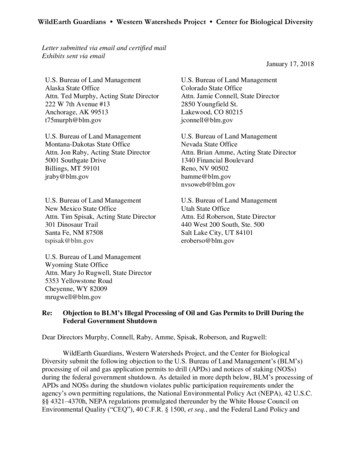
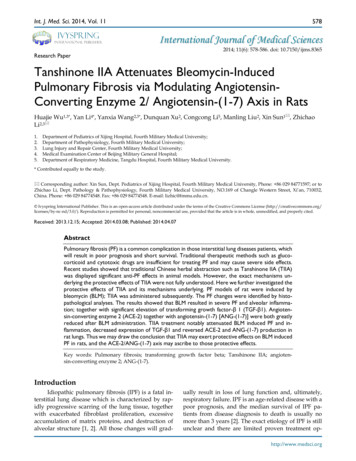
![State Protocol Agreement Between the Colorado State Director [Sd] of .](/img/43/co-20protocol.jpg)
